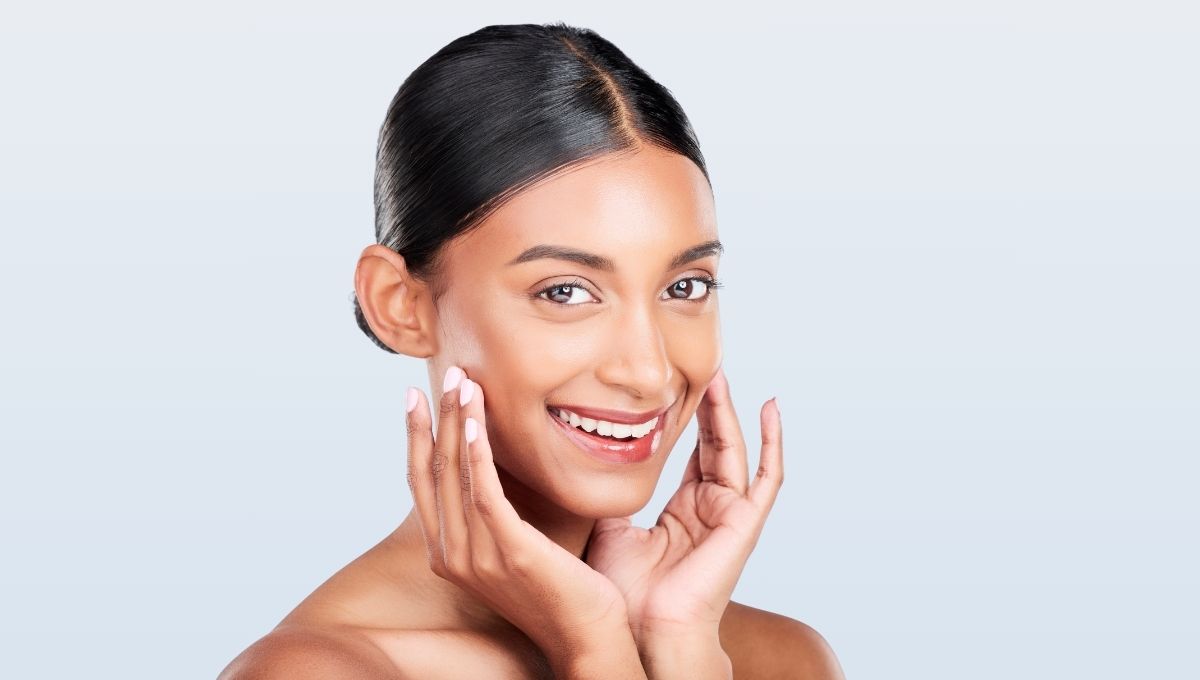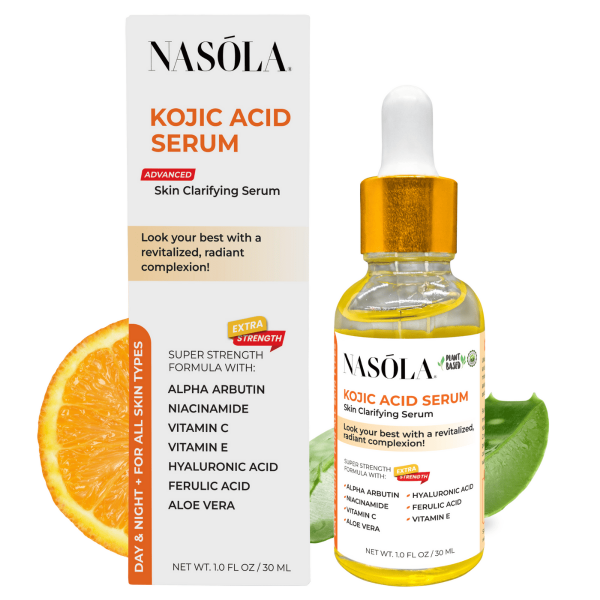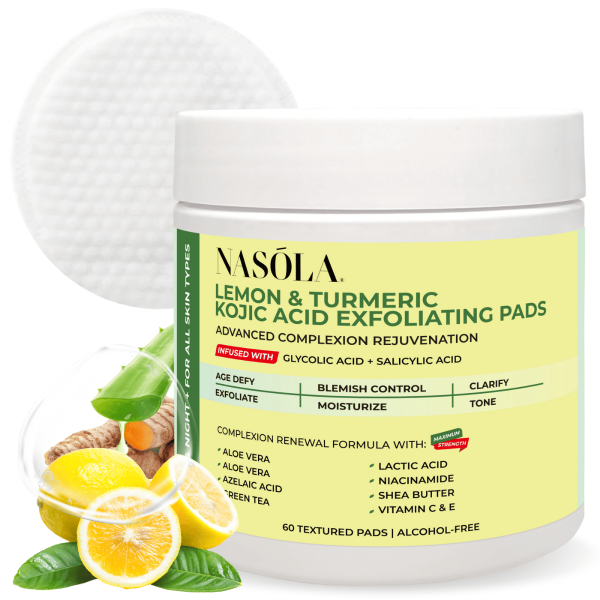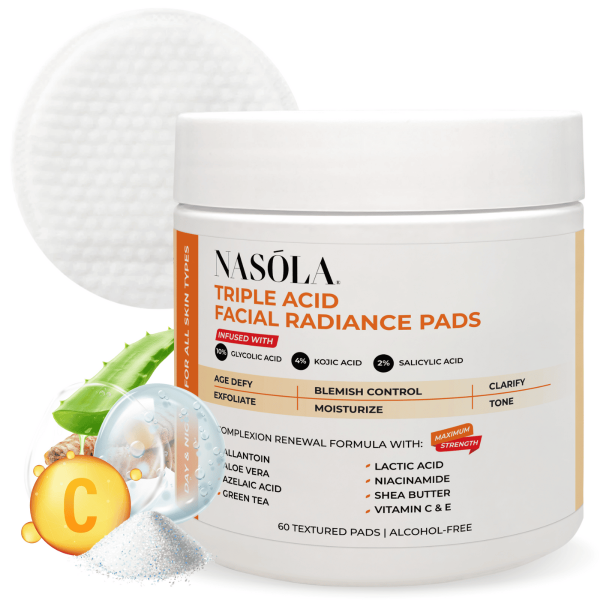It starts somewhere quiet… maybe late at night, or just after your makeup comes off.
You’re standing in front of the mirror. You tilt your head. Squint a little. And yep—there’s that shadowy smudge on your cheek again. Or along your jaw. Maybe under each eye. 💭
That’s where a high-quality facial fade cream enters the chat.
A facial fade cream is your daily sidekick in the journey to reduce stubborn dark spots, smooth uneven skin tone, and tackle hyperpigmentation with intention—without harsh side effects.
It targets melanin production (hello, science!) and reveals the brighter you hiding beneath the surface.
In this guide, we’ll help you figure out which facial fade cream belongs on your shelf—and spoiler, I’ll introduce a few game-changers from Nasola that we swear by: the Nasola Kojic Acid Cream, Nasola Kojic Acid Serum, Nasola Lemon Turmeric Kojic Pads, and the triple-acid glow-givers.
Feel like your skin’s done waiting? Let’s get glowing.✨
- The Best Facial Fade Cream: What Makes One Stand Out?
- Ingredient Spotlight: Kojic Acid's Role in an Effective Facial Fade Cream
- How to Choose the Best Facial Fade Cream for Your Skin Type
- Daily Routines That Maximize Facial Fade Cream Results
- Additional Benefits of Using a High-Quality Facial Fade Cream
- One More Thing: When Your Skin Feels Like It’s Stuck…
- Conclusion
- Frequently Asked Questions
The Best Facial Fade Cream: What Makes One Stand Out?
Not all fade creams are created equal—and it’s easy to get overwhelmed with the options. The best facial fade cream isn’t just about results. (Though trust us, we want that too.) It’s about safety, comfort, and visible transformation—ideally all at once. 🧴
So, what actually happens when you smooth that creamy miracle onto your skin every night?
Fade creams work by interfering directly with melanin production—the miracle pigment responsible for skin discoloration when it overproduces. Ingredients like kojic acid, niacinamide, and natural plant extracts help slow down that process.
When choosing a fade cream, think beyond promises. Look for:
- Transparent, proven ingredients like kojic acid
- Non-toxic formulas that are fragrance-free and cruelty-free
- Antioxidants that fight free radicals and support skin healing
- Dermatologically tested and suitable for multiple skin types
Understanding How Facial Fade Cream Works
Facial fade creams aren’t magic. But when used consistently, the results can feel like it.
These creams target the source: melanocytes. Melanocytes are the cells that produce melanin, and the body creates more melanin in areas where the skin is inflamed or sun-damaged. Enter dark spots, age spots, and uneven texture.
Kojic acid, arbutin, and other agents inhibit tyrosinase—an enzyme essential for melanin production—and thus, over time, your discolorations are gradually lightened.
When used daily, especially alongside gentle exfoliators and sun protection, fade creams can:
- Help reduce discoloration from sun exposure or hormonal changes
- Improve skin tone consistency over time
- Lessen leftover scars from acne
- Boost skin’s natural clarity and radiance
Consistency is the uncelebrated hero here. Use your cream religiously.
And let’s be clear…
The glow? Starts from discipline.
Qualities to Look for in the Best Facial Fade Cream
Finding the best facial fade cream means digging beneath the label. Because what your skin absorbs should serve you—not irritate you.
Some essentials to note when shopping for your fade cream:
- Non-Comedogenic Formulas: Won’t clog pores
- Natural Actives: Like kojic acid, vitamin C, licorice root, or arbutin
- No Artificial Fragrances or Dyes: Less chance of inflammation
- Packed with Antioxidants: To protect your skin barrier
🌼 Try the Nasola Kojic Acid Cream if your skin craves results without the sting. Balanced with kojic acid and nourishing botanicals, it hydrates while it fades—making it ideal for sensitive skin, and perfect for daily use.
Soft enough for everyday.
Strong enough to change everything.
Ingredient Spotlight: Kojic Acid’s Role in an Effective Facial Fade Cream
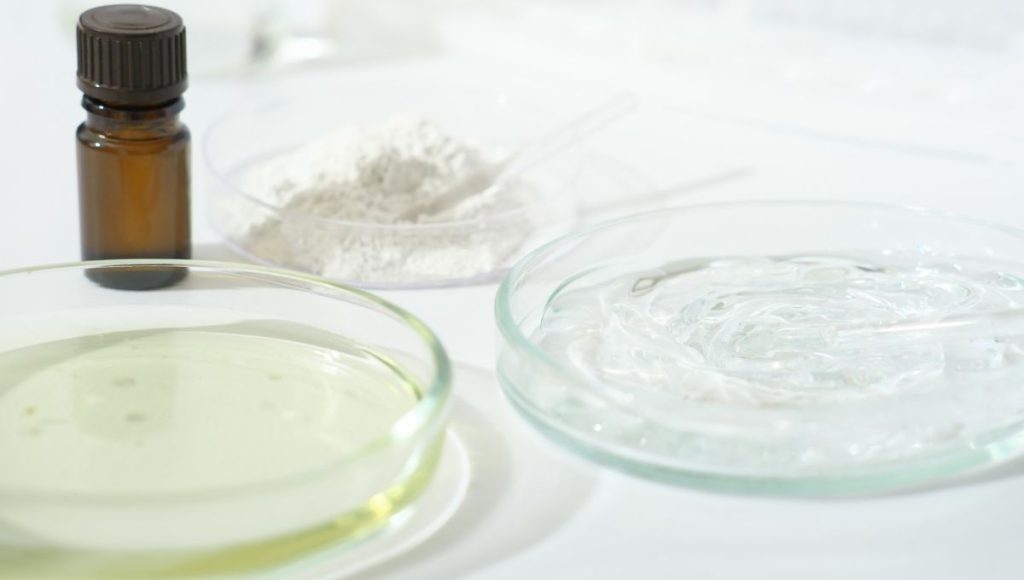
Let’s gush a little about kojic acid—the not-so-secret sauce that powers many of the most effective brightening routines, including today’s top facial fade creams.
Kojic acid has been quietly changing complexions for years. Derived naturally from rice fermentation (yes, rice!), it has a gentle, targeted approach to skin brightening and melanin regulation.
Its strength lies in its subtleness.💡
You won’t feel burning.
You won’t smell chemicals.
But after a few weeks? You’ll see smoother, more even-toned skin look back at you.
Why Kojic Acid Is a Powerhouse in Skin Brightening
Kojic acid became a staple in skincare for more than just its natural roots. It’s especially popular among women with melanin-rich skin seeking to gently treat hyperpigmentation without compromising their skin health.
It’s also effective at:
- Fading dark spots
- Treating melasma
- Tackling sun damage and environmental discoloration
- Offering antioxidant support to aged, tired skin
Because it doesn’t bleach or strip the skin, it’s safer for long-term use than harsher chemicals like hydroquinone.
Benefits of Kojic Acid in Facial Fade Creams
Kojic acid works calmly but powerfully over time. And best of all—it’s versatile.
It can be found in serums, spot treatments, masks, and creams.
The Nasola Kojic Acid Serum is one of the most potent and simple additions to any routine. Just a few drops a day on your trouble spots—under your cream—can speed up the fading process for stubborn discoloration.
Benefits include:
- Smooth skin texture
- Rapid fading of stubborn pigmentation
- Safe for layering with other treatments
- Hydrating base formula to prevent dryness
Like your skincare? Streamlined. ✨
How to Choose the Best Facial Fade Cream for Your Skin Type
You don’t have to settle. Promise.
Not every skin agrees with every formula. So before you commit to the best facial fade cream, ask: what does my skin need TODAY?
Oily skin? You’ll want something light that won’t clog you up. Dry skin? Bring on hydration. Sensitive skin? Gentle actives only, please.
Best for Oily and Acne-Prone Skin
People with acne-prone skin often deal with something sneakier than breakouts: the marks they leave behind.
To avoid clogged pores and inflammation:
- Choose non-comedogenic, gel-based fade creams
- Look for ingredients like salicylic acid and witch hazel
- Use at night and always pair with SPF in the morning
- Keep your layering simple—cleanser, serum, fade cream, SPF (AM)
Try pairing your routine with Nasola Triple Acid Facial Radiance Pads. With glycolic, lactic, and salicylic acids, they resurface skin gently and prep your face to absorb every powerhouse ingredient that comes after.
Use 2–3 times a week for:
- Smoother, more refined pores
- Less buildup causing acne
- Faster cell turnover for scar fading
- Brighter tone—without the grease
Best for Dry or Sensitive Skin Types
Dry and sensitive skin types have a love-hate relationship with creams.
Sometimes they sting.
Other times, they do… nothing 🤷♀️.
But with the right blend, even delicate skin can glow brighter.
Look for fade creams that are:
- Infused with hydrating agents like hyaluronic acid or glycerin
- Fragrance-free and pH-balanced
- Dermatologist-tested for sensitive skin
- Mixed with calming botanicals like green tea or chamomile
Want to supercharge this harmony? Add Nasola Lemon Turmeric Kojic Acid Exfoliating Pads into your routine once or twice a week. They combine turmeric (soothing) and kojic acid (fading) in one punchy, gentle pad.
Skin feels:
- Softer
- Calmer
- Instantly refreshed
And we love that combo, don’t we?
Daily Routines That Maximize Facial Fade Cream Results

Okay—here’s the deal: even best-in-class fade creams can’t fight alone.
They like company. Strategic allies. A team.
That’s why the way you layer and support your products makes all the difference in what you see weeks from now.
Layering Products: When and Where to Apply
Applying your fade cream at the wrong time (or with the wrong product) is like wearing socks in the shower.
Not ideal.
Here’s your confidence-boosting AM/PM cheat sheet:
Morning:
- Gentle Cleanser
- Hydrating Toner (optional)
- Nasola Kojic Acid Serum – Apply to target areas
- Face Moisturizer
- Broad-Spectrum SPF 30+
Night:
- Cleanse
- Exfoliate 2–3x/week (hello, Nasola Triple Acid Pads)
- Apply Nasola Kojic Acid Cream
- Lock in moisture if needed with a night cream
SPF is a non-negotiable after fade cream use. It protects your progress!
Pairing with Exfoliation Treatments
Dead skin? It blocks everything.
Exfoliating allows your cream to slide right in—no resistance.
Use Nasola Lemon Turmeric Kojic Acid Pads weekly to:
- Gently remove buildup without microtears
- Brighten skin from Day 1
- Allow deeper penetration of your fade cream
- Stabilize skin tone and reduce discoloration
Keep this bi-weekly and don’t overdo it.
Glow happens when skin is treated with patience. ☀️
Additional Benefits of Using a High-Quality Facial Fade Cream
A great facial fade cream isn’t just about pigment.
Long-term use can improve your entire relationship with your skin. Less inflammation. More bounce. That dewy, effortless confidence you can feel walking into a meeting or going makeup-free on a weekend.
Not Just for Hyperpigmentation: Reducing Acne Scars and Uneven Texture
It’s wild how much smoother your skin can feel—even if scars have faded only slightly.
That’s because these creams also:
- Minimize pore visibility
- Encourage cellular renewal
- Blur rough patches over time
- Provide subtle exfoliation (especially when paired with acids)
Long-Term Skin Health: Boosting Collagen and Preventing Future Spots
Some of the best cream ingredients multitask. Kojic acid, vitamin C, and niacinamide have antioxidant benefits that help combat oxidative stress.
This means visibly:
- Fewer fine lines over time
- Protection against sun damage
- Skin barrier strength increased
- Reduced likelihood of future pigmentation
One More Thing: When Your Skin Feels Like It’s Stuck…

Here’s something people don’t tell you enough:
Facial fade cream results can plateau if your skin barrier is compromised.
So…
If your cream suddenly stops “working,” assess your hydration, your exfoliation frequency, and your sun exposure.
Try this refresh:
- Take a 2-day exfoliation break
- Boost hydration with a hyaluronic serum
- Restart your fade cream on freshly balanced skin
- Don’t skip SPF—not even on cloudy days
Your skin’s just whispering: “Help me help you.”
Conclusion
The journey to brighter, more even skin doesn’t have to be confusing or overwhelming.
With a high-performing facial fade cream like the Nasola Kojic Acid Cream, and game-changing companions like Nasola Triple Acid Pads or Nasola Lemon Turmeric Kojic Pads, you’re not just treating spots—you’re transforming your skin’s future.
Remember that kojic acid is gentle, natural, and effective across all skin tones. When used correctly, it delivers clarity, radiance, and confidence in your reflection.
So take this as your sky-high sign:
Your skin is ready.
Start your fade journey now—powered by intention, supported by science, and enriched by Nasola.
Frequently Asked Questions
A facial fade cream targets dark spots, uneven skin tone, and hyperpigmentation by slowing down melanin production. Active ingredients like kojic acid help block the tyrosinase enzyme, revealing gradually brighter and smoother skin when used regularly.
The Nasola Kojic Acid Cream is among the best due to its effective yet safe formulation. It combines kojic acid with hydrating botanical extracts to gently fade hyperpigmentation while nourishing sensitive or combination skin.
Most users begin noticing improvement within 2–4 weeks of consistent use. Pairing the cream with exfoliation products like Nasola Lemon Turmeric Kojic Pads can accelerate your results.
Yes. Most facial fade creams, including kojic acid-based ones, are designed for daily use. Always apply a moisturizer and SPF during the day to protect your results and skin barrier.
Absolutely. Kojic acid is a naturally derived ingredient suitable for all skin tones. Unlike some bleaching agents, it works gradually and gently, making it safer for melanin-rich skin.
Definitely. Using a serum like the Nasola Kojic Acid Serum before your fade cream enhances penetration and boosts fading for stubborn dark spots. Just layer serum first, then cream.
Yes. Many fade creams—especially those with kojic and glycolic acid—help lighten post-acne marks. Try complementing your cream with Nasola Triple Acid Radiance Pads for texture and brightness improvement.
Some fade creams may cause irritation if overused or combined with harsh exfoliants. Always patch-test first, introduce gradually, and avoid over-exfoliating. Go slowly and support your skin barrier.
Yes. Regular, mild exfoliation removes dead skin cells that block absorption of your cream. Using pads like Nasola Lemon Turmeric Kojic Pads 2–3 times per week can maximize cream performance.
Most fade creams can be used long-term, especially those with gentle ingredients like kojic acid. After significant improvement, many people reduce to 3x per week for maintenance.

